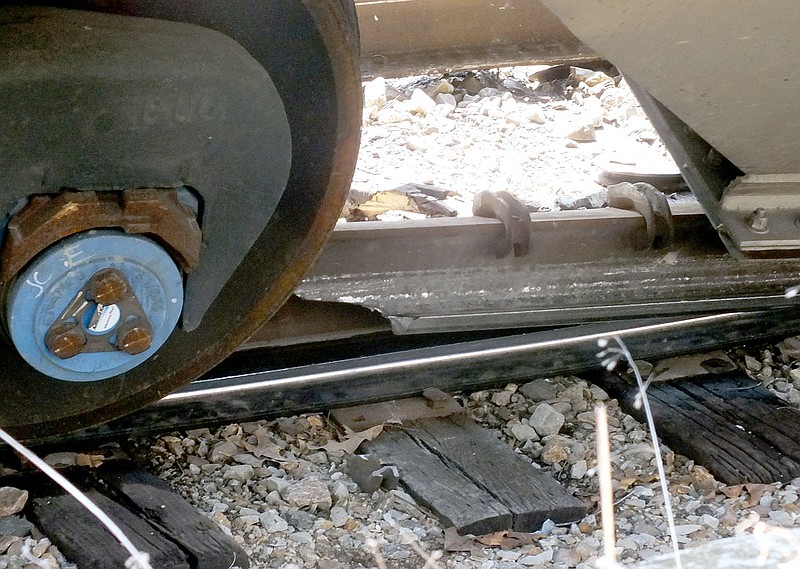Intermingled with the sounds of rumbling thunder Tuesday, April 8, was a similar, but different noise. Thunderstorms were moving through northeast Benton County about 11 a.m. Tuesday, but the loud noise several area residents heard wasn't thunder.
It was 20 railroad cars colliding with one another, falling off the track and into a rock wall alongside one side of the railroad bed.
The cause of the derailment was a piece of broken rail, Ron Sparks, chief of railroad police, said Tuesday, April 25, a week after the crash.
"There was a hairline fracture in a piece of rail about 10 feet north of the crossing," Sparks said. "It's been below the surface for a while."
He said the rails are inspected twice a week, but this type of crack can only been seen by x-ray.
Curious neighbors
"I heard a loud noise," Karma Neese said, "it sounded like thunder."
Neese, who said she lives about a quarter of a mile from the site of the derailment, said she has lived there for 22 years and seen trains derail in the area before, the last time being about eight years ago.
Neese, along with several people from the Garfield area, drove down Roberts Loop looking at the damage.
Dale Watkins, a Garfield City Council member, was on the scene to see if any hazardous materials had been spilled. "There were no hazardous materials," Watkins said, "and no bodies."
Many area residents drove or walked around the area.
"You don't get this kind of excitement in Garfield very often," Linus Shockley Jr. said as his father, Linus Shockley Sr., crossed the tracks to take pictures from the other side of the tracks.
"It sounded like thunder," Shockley Jr. said. "We figured we'd come down here and check it out."
James Appleton, parks and water superintendent for Gateway, was on the scene to check water lines in the area, none of which were affected, he said.
Scene cleared
Trains were again running through the Garfield area by 4 p.m. Friday. A team of 40 men worked 16-hour days for four days rebuilding track, Sparks said, adding that 2,100 feet of rail were replaced. He estimated the damage cost from $750,000 to $900,000.
Sparks said trains ran overtime over the weekend once the tracks were opened to make up for lost runs during the week the tracks were closed.
"We're caught up now," Sparks said Tuesday.
Within two hours of the crash, at 1:12 p.m. April 8, a train whistle was heard and another train arrived on the scene from the west to pull the upright cars away from the wreck site. More equipment was on the way to remove the wrecked cars.
At the accident scene, Sparks said the derailment was not caused by weather or human error, but wouldn't speculate about the cause until he had finished his investigation. Sparks covers the area for the railroad from Fort Smith to Monett, Mo., and has worked for the Arkansas & Missouri Railroad for 17 years. He said he's been to several classes on train derailment. He investigated the scene to determine the cause.
He said this train goes through twice daily -- once up to Monett and once back to Springdale/Fort Smith. At Monett, it "interchanges" with Burlington-Northern.
Twenty of 45 cars derailed beginning with back cars just off Roberts Loop and U.S. Highway 62, with five of those cars lying on their sides forming an accordion shape zigzagging across the tracks. Further up the tracks, several cars tipped to the side with the wheels off the twisted tracks and limestone rocks broken away from the edge of the hillside nearby.
"The engineer, Bill Wheeler, is one of our best engineers," Sparks said, adding that Wheeler has worked for the railroad for 24 years. "He's very experienced and knows what he's doing."
The train cars were carrying mostly sand -- masonry sand and fracking sand, Sparks said.
Sparks said the wreck began in the back, near the first driveway off the west end of Roberts Loop.
"It started back here. Once it started pulling away from the train, it looses air and the train pulled apart. He (the engineer felt it)," Sparks said. He said that equipment would be sent to the site from Kansas City and Wichita to right the cars and rebuild the train tracks immediately. The driveway that was blocked was cleared that afternoon.
General News on 04/16/2014
